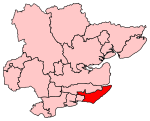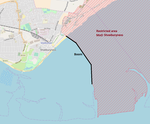Great Wakering
Burial sites of the House of KentRochford DistrictVillages in Essex

Great Wakering is a village in the Rochford District in Essex, England. It is approximately four miles east of Southend. Great Wakering consists mainly of two roads: the High Street, which runs from the junction of Star Lane, and New Road, which begins outside St. Nicholas' Parish Church and runs down to the bridges for Foulness Island.
Excerpt from the Wikipedia article Great Wakering (License: CC BY-SA 3.0, Authors, Images).Great Wakering
New Road, Essex
Geographical coordinates (GPS) Address Nearby Places Show on map
Geographical coordinates (GPS)
| Latitude | Longitude |
|---|---|
| N 51.5516 ° | E 0.8165 ° |
Address
New Road
New Road
SS3 0AR Essex, Great Wakering
England, United Kingdom
Open on Google Maps









